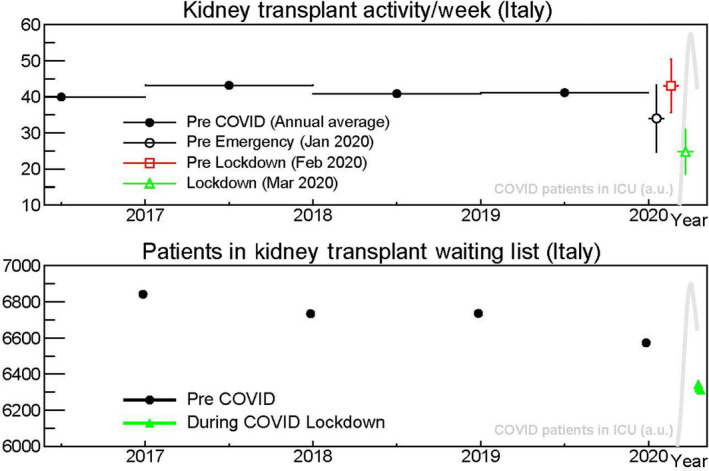The coronavirus disease 2019 (COVID‐19) disrupted the healthcare system: when ‘business as usual’ is no longer possible, as intensive care units (ICUs) follow the principle of ‘capacity to benefit’ to accommodate as many COVID‐19 patients requiring ventilation as possible, there is an important decrease in the organ pool [1]. The lack of ICU capacity to accommodate donors dying from different reasons than COVID‐19 leads to a drastic reduction of the transplant activity, important resource to be preserved in a safe and clean environment, separated by the rest of the dedicated COVID‐19 beds. There is evidence, in fact, that COVID‐19 could be a nosocomial infection [2].
Furthermore, transplantation requires immunosuppression. In population at risk, the innate immune system fails to produce an adequate adaptive response, so persistent self‐induced inflammation can cause mortality and mounting an early adaptive immune response may save lives [3], a concept that fails to match with the required post‐transplant immunosuppression.
In addition, living donation has been suspended in most centres as considered too high‐risk procedure for a healthy individual who would not need to come to the hospital, if not for the wish to donate. Preliminary data from Italy show already a 30% reduction in kidney transplant activity during the lockdown, in parallel with ICU COVID‐19 beds crisis (Fig. 1).
Figure 1.

Kidney transplant activity and patients on the waiting list in Italy pre‐ (2017–2019) and post‐COVID‐19 outbreak (2020). The drop in the activity is consistent with also significantly less people on the waitlist due to the uncertainty faced in 2020, particularly after the lockdown declared by the Italian Government in March 2020. With a progressive control over the pandemic, as shown by the COVID‐19 patients in the intensive care unit (ICU), kidney transplant activity is expected to be run again. Data from https://trapianti.sanita.it/statistiche/archivio.aspx and https://unos.org/covid‐webinars/.
In the ethical attempt to provide the best care to COVID‐19 patients and prevent their deaths, we should also consider the lack of adequate treatment for those who would have benefitted from the ICU resource and that due to the delay in care will eventually die. This applies to major transplant operations as heart and liver, considered life‐saving procedures; the reduction in the number of these procedures is less evident as most centres did not suspend their activity, although the lockdown effect is present too (Table 1).
Table 1.
Transplant activity in Italy pre‐ (2017–2019) and post‐COVID‐19 outbreak (2020).
| Year | Transplant activity | |||||||
|---|---|---|---|---|---|---|---|---|
| Total | RMS | Kidney | RMS | Liver | RMS | Heart | RMS | |
| Pre‐COVID‐19 | ||||||||
| 2017 | 75.96 | 0.00 | 43.15 | 0.00 | 25.23 | 0.00 | 5.10 | 0.00 |
| 2018 | 71.63 | 0.00 | 40.85 | 0.00 | 23.96 | 0.00 | 4.48 | 0.00 |
| 2019 | 73.33 | 0.00 | 41.13 | 0.00 | 25.02 | 0.00 | 4.71 | 0.00 |
| Post‐COVID‐19 outbreak | ||||||||
| 2020 Jan | 68.80 | 14.87 | 34.00 | 9.30 | 27.80 | 4.87 | 4.80 | 1.30 |
| 2020 Feb | 81.25 | 12.53 | 43.00 | 7.39 | 27.75 | 4.57 | 7.50 | 1.73 |
| 2020 Mar | 44.80 | 12.83 | 24.80 | 6.14 | 15.80 | 4.15 | 3.00 | 2.12 |
RMS, root mean square.
The drop is consistent for all organs, but particularly for the kidney and in March, with the concomitant lockdown declared by the Italian Government. Data from https://trapianti.sanita.it/statistiche/archivio.aspx and https://unos.org/covid‐webinars/.
With a progressive improvement over the control on the COVID‐19 pandemic, shown also in the numbers of COVID‐19 ICU patients, there is discussion on how to re‐open and safely run a kidney transplant programme, given previous reports of serious illness with ICU admission and acute kidney injury [4]. When the lockdown will be lifted, a careful selection of transplant candidates will be recommended, in terms of underlying comorbidities, avoiding the elderly, diabetic and patients with chronic pulmonary disease, more at risk of dying for COVID‐19 [5] and selecting good matched candidates, requiring less immunosuppression, with preferably standard donors, more likely to lead to primary function and early patient discharge.
Funding
There was no external funding source.
Conflict of interest
The authors declare no conflict of interest.
References
- 1. Martino F, Plebani M, Ronco C. Kidney transplant programmes during the COVID‐19 pandemic. Lancet Respir Med 2020; 8: e39. [DOI] [PMC free article] [PubMed] [Google Scholar]
- 2. Ye G, Lin H, Chen L, et al. Environmental contamination of the SARS‐CoV‐2 in healthcare premises: an urgent call for protection for healthcare workers. medRxiv 2020; 2020. 2003.2011.20034546. [Google Scholar]
- 3. Ahmadpoor P, Rostaing L. Why the immune system fails to mount an adaptive immune response to a COVID‐19 infection. Transpl Int 2020; 33: 824. [DOI] [PubMed] [Google Scholar]
- 4. Akalin E, Azzi Y, Bartash R, et al. Covid‐19 and kidney transplantation. N Engl J Med 2020.doi: 10.1056/NEJMc 2011117 [epub ahead of print] [DOI] [PMC free article] [PubMed] [Google Scholar]
- 5. Onder G, Rezza G, Brusaferro S. Case‐fatality rate and characteristics of patients dying in relation to COVID‐19 in Italy. JAMA 2020;328:1775–1776. [DOI] [PubMed] [Google Scholar]


